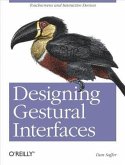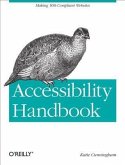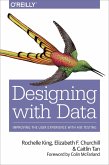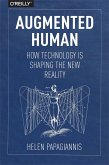Designing for Emerging Technologies (eBook, PDF)
UX for Genomics, Robotics, and the Internet of Things


Alle Infos zum eBook verschenken

Designing for Emerging Technologies (eBook, PDF)
UX for Genomics, Robotics, and the Internet of Things
- Format: PDF
- Merkliste
- Auf die Merkliste
- Bewerten Bewerten
- Teilen
- Produkt teilen
- Produkterinnerung
- Produkterinnerung

Hier können Sie sich einloggen

Bitte loggen Sie sich zunächst in Ihr Kundenkonto ein oder registrieren Sie sich bei bücher.de, um das eBook-Abo tolino select nutzen zu können.
The recent digital and mobile revolutions are a minor blip compared to the next wave of technological change, as everything from robot swarms to skin-top embeddable computers and bio printable organs start appearing in coming years. In this collection of inspiring essays, designers, engineers, and researchers discuss their approaches to experience design for groundbreaking technologies.Design not only provides the framework for how technology works and how its used, but also places it in a broader context that includes the total ecosystem with which it interacts and the possibility of…mehr
- Geräte: PC
- mit Kopierschutz
- eBook Hilfe
- Größe: 32.83MB
- FamilySharing(5)
![Designing Gestural Interfaces (eBook, PDF) Designing Gestural Interfaces (eBook, PDF)]() Dan SafferDesigning Gestural Interfaces (eBook, PDF)33,95 €
Dan SafferDesigning Gestural Interfaces (eBook, PDF)33,95 €![Brain-Computer Interfaces (eBook, PDF) Brain-Computer Interfaces (eBook, PDF)]() Brain-Computer Interfaces (eBook, PDF)72,95 €
Brain-Computer Interfaces (eBook, PDF)72,95 €![Microinteractions: Full Color Edition (eBook, PDF) Microinteractions: Full Color Edition (eBook, PDF)]() Dan SafferMicrointeractions: Full Color Edition (eBook, PDF)22,95 €
Dan SafferMicrointeractions: Full Color Edition (eBook, PDF)22,95 €![Accessibility Handbook (eBook, PDF) Accessibility Handbook (eBook, PDF)]() Katie CunninghamAccessibility Handbook (eBook, PDF)12,95 €
Katie CunninghamAccessibility Handbook (eBook, PDF)12,95 €![Designing with Data (eBook, PDF) Designing with Data (eBook, PDF)]() Rochelle KingDesigning with Data (eBook, PDF)23,95 €
Rochelle KingDesigning with Data (eBook, PDF)23,95 €![Augmented Human (eBook, PDF) Augmented Human (eBook, PDF)]() Helen PapagiannisAugmented Human (eBook, PDF)23,95 €
Helen PapagiannisAugmented Human (eBook, PDF)23,95 €![Calm Technology (eBook, PDF) Calm Technology (eBook, PDF)]() Amber CaseCalm Technology (eBook, PDF)13,95 €
Amber CaseCalm Technology (eBook, PDF)13,95 €-
-
-
Dieser Download kann aus rechtlichen Gründen nur mit Rechnungsadresse in A, B, BG, CY, CZ, D, DK, EW, E, FIN, F, GR, HR, H, IRL, I, LT, L, LR, M, NL, PL, P, R, S, SLO, SK ausgeliefert werden.
- Produktdetails
- Verlag: O'Reilly Media
- Seitenzahl: 504
- Erscheinungstermin: 7. November 2014
- Englisch
- ISBN-13: 9781449370664
- Artikelnr.: 41836963
- Verlag: O'Reilly Media
- Seitenzahl: 504
- Erscheinungstermin: 7. November 2014
- Englisch
- ISBN-13: 9781449370664
- Artikelnr.: 41836963
- Herstellerkennzeichnung Die Herstellerinformationen sind derzeit nicht verfügbar.
Foreword
Preface
Why We Wrote This Book
How This Book Is Organized
Chapters Organized By Subject Area
Safari® Books Online
How to Contact Us
Acknowledgments
Chapter 1: Designing for Emerging Technologies
1.1 A Call to Arms
1.2 Design for Disruption
1.3 Eight Design Tenets for Emerging Technology
1.4 Changing Design and Designing Change
Chapter 2: Intelligent Materials: Designing Material Behavior
2.1 Bits and Atoms
2.2 Emerging Frontiers in Additive Manufacturing
2.3 Micro Manufacturing
2.4 Dynamic Structures and Programmable Matter
2.5 Connecting the Dots: What Does Intelligent Matter Mean for Designers?
2.6 Conclusion
Chapter 3: Taking Control of Gesture Interaction
3.1 Reinventing the User Experience
3.2 Analysis
3.3 Prototyping
3.4 A Case Study: Gesture Control
3.5 Trade-offs
3.6 Looking Ahead
Chapter 4: Fashion with Function: Designing for Wearables
4.1 The Next Big Wave in Technology
4.2 The Wearables Market Segments
4.3 Wearables Are Not Alone
4.4 UX (and Human) Factors to Consider
4.5 Summary
Chapter 5: Learning and Thinking with Things
5.1 Tangible Interfaces
5.2 (Near) Future Technology
5.3 Timeless Design Principles?
5.4 Farther Out, a Malleable Future
5.5 Nothing New Under the Sun
5.6 Closing
Chapter 6: Designing for Collaborative Robotics
6.1 Introduction
6.2 Designing Safety Systems for Robots
6.3 Humanlike Robots
6.4 Human-Robot Collaboration
6.5 Testing Designs by Using Robotics Platforms
6.6 Future Challenges for Robots Helping People
6.7 Conclusion
6.8 Robotics Resources
Chapter 7: Design Takes on New Dimensions: Evolving Visualization Approaches for Neuroscience and Cosmology
7.1 The Brain Is Wider Than the Sky
7.2 Section 1: An Expanding Palette for Visualization
7.3 Section 2: Visualizing Scientific Models (Some Assembly Required)
7.4 Section 3: Evolving Tools, Processes, and Interactions
7.5 Conclusion
Chapter 8: Embeddables: The Next Evolution of Wearable Tech
8.1 Technology That Gets Under Your Skin
8.2 Permeable Beings: The History of Body Modification
8.3 Decoration, Meaning, and Communication
8.4 Optimization and Repair
8.5 The Extended Human
8.6 Just Science Fiction, Right?
8.7 Key Questions to Consider
Chapter 9: Prototyping Interactive Objects
9.1 Misconceptions Surrounding Designers Learning to Code
Chapter 10: Emerging Technology and Toy Design
10.1 The Challenge of Toy Design
10.2 Toys and the S-Curve
10.3 Toys and Intellectual Property
10.4 Emerging Technologies in Toy Design
10.5 Inherently Playful Technology
10.6 Sensors and Toy Design
10.7 Emerging Technology in Production and Manufacturing
10.8 Summary
Chapter 11: Musical Instrument Design
11.1 Experience Design and Musical Instruments
11.2 The Evolution of the Musician
11.3 Conclusion
Chapter 12: Design for Life
12.1 Bloodletting to Bloodless
12.2 The Surveillance Invasion
12.3 Life First-Health a Distant Second
12.4 Stage Zero Detection
12.5 From Protein to Pixel to Policy
12.6 Final Thoughts
Chapter 13: Architecture as Interface: Advocating a Hybrid Design Approach for Interconnected Environments
13.1 The Blur of Interconnected Environments
13.2 Theorizing Digital Culture: New Models of Convergence
13.3 Hybrid Design Practice
13.4 Changing Definitions of Space
13.5 A Framework for Interconnected Environments
13.6 Spheres of Inquiry
13.7 An Exercise in Hybrid Design Practice
13.8 Architecture as Interface
13.9 Conclusion
13.10 References
Chapter 14: Design for the Networked World: A Practice for the Twenty-First Century
14.1 The Future of Design
14.2 New Environment, New Materials
14.3 New Tools for a New Craft
Chapter 15: New Responsibilities of the Design Discipline: A Critical Counterweight to the Coming Technologies?
15.1 Critiquing Emerging Technology
15.2 Emerging Technologies
15.3 New Responsibilities of the Design Discipline
15.4 Bibliography
Chapter 16: Designing Human-Robot Relationships
16.1 Me Man, You Robot: Designers Creating Powerful Tools
16.2 Me Man, You Robot? Developing Emotional Relationships with Robots
16.3 Me Robot? On Becoming Robotic
16.4 Into the Future
16.5 Your Robot: Consider Nielsen, Maslow, and Aristotle
16.6 Conclusion
Chapter 17: Tales from the Crick: Experiences and Services When Design Fiction Meets Synthetic Biology
17.1 Design Fictions as a Speculative Tool to Widen the Understanding of Technology
17.2 The Building Bricks of the Debate
17.3 Healthcare Narratives: From Scenarios to Societal Debates
17.4 Living Objects: Symbiotic Indispensable Companions
Chapter 18: Beyond 3D Printing: The New Dimensions of Additive Fabrication
18.1 MIT and the Mediated Matter Group: Previous and Current Additive Fabrication Research
18.2 The Dimensions of Additive Fabrication
18.3 Conclusion
Chapter 19: Become an Expert at Becoming an Expert
19.1 Into the Fire
19.2 Eating the Elephant
19.3 Onward
Chapter 20: The Changing Role of Design
20.1 On the Impact of Emerging Technologies
20.2 Design Complexity and Emerging Technologies
20.3 Design Trends for Emerging Technologies
20.4 User Experience: Finding Its Level
20.5 The Future for Me, the Future for You
Companies, Products, and Links
About the Authors
Designing for Emerging Technologies
Foreword
Preface
Why We Wrote This Book
How This Book Is Organized
Chapters Organized By Subject Area
Safari® Books Online
How to Contact Us
Acknowledgments
Chapter 1: Designing for Emerging Technologies
1.1 A Call to Arms
1.2 Design for Disruption
1.3 Eight Design Tenets for Emerging Technology
1.4 Changing Design and Designing Change
Chapter 2: Intelligent Materials: Designing Material Behavior
2.1 Bits and Atoms
2.2 Emerging Frontiers in Additive Manufacturing
2.3 Micro Manufacturing
2.4 Dynamic Structures and Programmable Matter
2.5 Connecting the Dots: What Does Intelligent Matter Mean for Designers?
2.6 Conclusion
Chapter 3: Taking Control of Gesture Interaction
3.1 Reinventing the User Experience
3.2 Analysis
3.3 Prototyping
3.4 A Case Study: Gesture Control
3.5 Trade-offs
3.6 Looking Ahead
Chapter 4: Fashion with Function: Designing for Wearables
4.1 The Next Big Wave in Technology
4.2 The Wearables Market Segments
4.3 Wearables Are Not Alone
4.4 UX (and Human) Factors to Consider
4.5 Summary
Chapter 5: Learning and Thinking with Things
5.1 Tangible Interfaces
5.2 (Near) Future Technology
5.3 Timeless Design Principles?
5.4 Farther Out, a Malleable Future
5.5 Nothing New Under the Sun
5.6 Closing
Chapter 6: Designing for Collaborative Robotics
6.1 Introduction
6.2 Designing Safety Systems for Robots
6.3 Humanlike Robots
6.4 Human-Robot Collaboration
6.5 Testing Designs by Using Robotics Platforms
6.6 Future Challenges for Robots Helping People
6.7 Conclusion
6.8 Robotics Resources
Chapter 7: Design Takes on New Dimensions: Evolving Visualization Approaches for Neuroscience and Cosmology
7.1 The Brain Is Wider Than the Sky
7.2 Section 1: An Expanding Palette for Visualization
7.3 Section 2: Visualizing Scientific Models (Some Assembly Required)
7.4 Section 3: Evolving Tools, Processes, and Interactions
7.5 Conclusion
Chapter 8: Embeddables: The Next Evolution of Wearable Tech
8.1 Technology That Gets Under Your Skin
8.2 Permeable Beings: The History of Body Modification
8.3 Decoration, Meaning, and Communication
8.4 Optimization and Repair
8.5 The Extended Human
8.6 Just Science Fiction, Right?
8.7 Key Questions to Consider
Chapter 9: Prototyping Interactive Objects
9.1 Misconceptions Surrounding Designers Learning to Code
Chapter 10: Emerging Technology and Toy Design
10.1 The Challenge of Toy Design
10.2 Toys and the S-Curve
10.3 Toys and Intellectual Property
10.4 Emerging Technologies in Toy Design
10.5 Inherently Playful Technology
10.6 Sensors and Toy Design
10.7 Emerging Technology in Production and Manufacturing
10.8 Summary
Chapter 11: Musical Instrument Design
11.1 Experience Design and Musical Instruments
11.2 The Evolution of the Musician
11.3 Conclusion
Chapter 12: Design for Life
12.1 Bloodletting to Bloodless
12.2 The Surveillance Invasion
12.3 Life First-Health a Distant Second
12.4 Stage Zero Detection
12.5 From Protein to Pixel to Policy
12.6 Final Thoughts
Chapter 13: Architecture as Interface: Advocating a Hybrid Design Approach for Interconnected Environments
13.1 The Blur of Interconnected Environments
13.2 Theorizing Digital Culture: New Models of Convergence
13.3 Hybrid Design Practice
13.4 Changing Definitions of Space
13.5 A Framework for Interconnected Environments
13.6 Spheres of Inquiry
13.7 An Exercise in Hybrid Design Practice
13.8 Architecture as Interface
13.9 Conclusion
13.10 References
Chapter 14: Design for the Networked World: A Practice for the Twenty-First Century
14.1 The Future of Design
14.2 New Environment, New Materials
14.3 New Tools for a New Craft
Chapter 15: New Responsibilities of the Design Discipline: A Critical Counterweight to the Coming Technologies?
15.1 Critiquing Emerging Technology
15.2 Emerging Technologies
15.3 New Responsibilities of the Design Discipline
15.4 Bibliography
Chapter 16: Designing Human-Robot Relationships
16.1 Me Man, You Robot: Designers Creating Powerful Tools
16.2 Me Man, You Robot? Developing Emotional Relationships with Robots
16.3 Me Robot? On Becoming Robotic
16.4 Into the Future
16.5 Your Robot: Consider Nielsen, Maslow, and Aristotle
16.6 Conclusion
Chapter 17: Tales from the Crick: Experiences and Services When Design Fiction Meets Synthetic Biology
17.1 Design Fictions as a Speculative Tool to Widen the Understanding of Technology
17.2 The Building Bricks of the Debate
17.3 Healthcare Narratives: From Scenarios to Societal Debates
17.4 Living Objects: Symbiotic Indispensable Companions
Chapter 18: Beyond 3D Printing: The New Dimensions of Additive Fabrication
18.1 MIT and the Mediated Matter Group: Previous and Current Additive Fabrication Research
18.2 The Dimensions of Additive Fabrication
18.3 Conclusion
Chapter 19: Become an Expert at Becoming an Expert
19.1 Into the Fire
19.2 Eating the Elephant
19.3 Onward
Chapter 20: The Changing Role of Design
20.1 On the Impact of Emerging Technologies
20.2 Design Complexity and Emerging Technologies
20.3 Design Trends for Emerging Technologies
20.4 User Experience: Finding Its Level
20.5 The Future for Me, the Future for You
Companies, Products, and Links
About the Authors
Designing for Emerging Technologies







